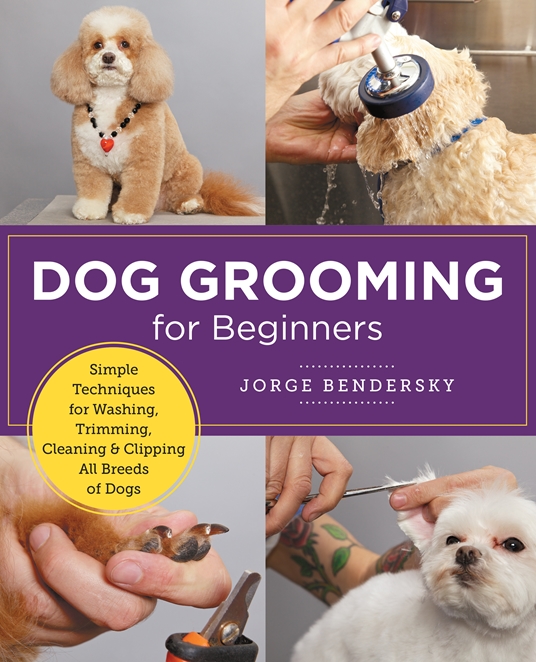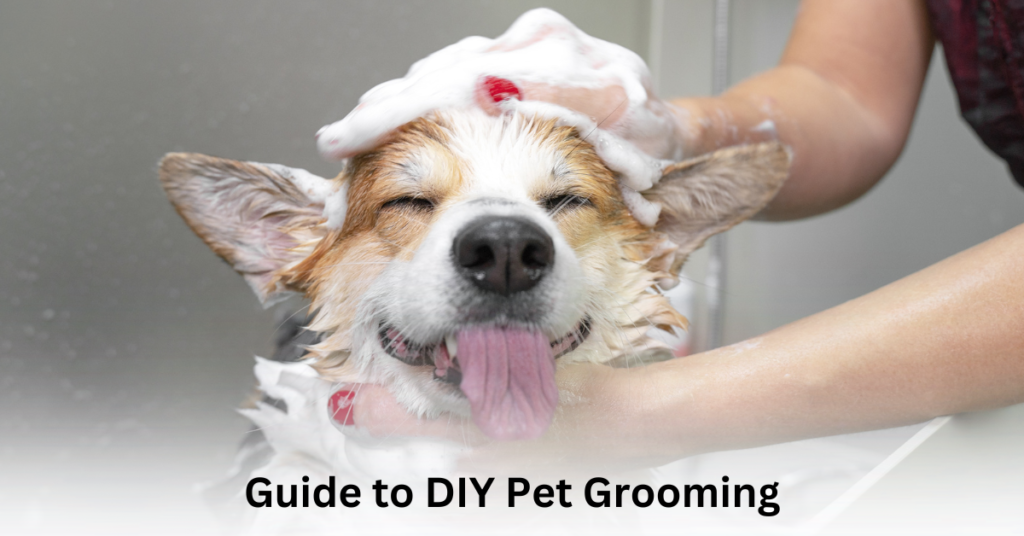For beginners, DIY dog grooming tips for grooming at home. Learn how to properly groom your dog at home to keep their coat healthy and tidy.
Taking care of your dog’s grooming needs can be a rewarding experience and help you bond with your furry friend. With the right tools and techniques, you can groom your dog at home without the stress and expense of regular professional grooming appointments.
We’ll explore some essential tips for beginners to groom their dogs at home effectively and safely. Whether you have a long-haired or short-haired breed, these tips will help you keep your pup looking and feeling their best.
Why Diy Dog Grooming?
Grooming your dog at home can have several benefits for both you and your furry friend. Not only does it save money, but it also provides an opportunity to bond with your dog in a meaningful way. Plus, it allows for personalized care, creating a more comfortable experience for your pet.
Save Money
Professional grooming services can be costly, especially if your dog requires frequent grooming sessions. By learning to groom your dog at home, you can save a significant amount of money over time. With some practice and the right tools, you can achieve professional-looking results without the hefty price tag.
Bond With Your Dog
Grooming your dog is a wonderful opportunity to strengthen your bond. It allows for quality one-on-one time, helping to build trust and mutual affection between you and your pet. This hands-on care also helps you become more attuned to your dog’s needs and preferences, fostering a deeper connection.
Essential Tools For Diy Dog Grooming
Dog grooming is an important part of pet care and can help keep your furry friend healthy and happy. To get started with DIY grooming, you’ll need some essential tools to ensure the process goes smoothly. Here are the must-have tools for DIY dog grooming:
Grooming Brush
A high-quality grooming brush is essential for keeping your dog’s coat in top condition. Regular brushing helps prevent mats and tangles, removes loose fur, and stimulates the skin. Look for a brush that is suitable for your dog’s coat type, whether it’s short, long, curly, or wiry.
Nail Clippers
Keeping your dog’s nails trimmed is crucial for their comfort and mobility. Invest in a pair of sharp, sturdy nail clippers designed specifically for dogs. Be sure to have styptic powder on hand in case you accidentally cut the quick and your dog starts bleeding.
Thinning Shears
Thinning shears are useful for blending and shaping your dog’s coat, especially for breeds with thick or double coats. These specialized scissors allow you to trim fur without creating harsh lines, giving your dog a more natural look.
Ear Cleaning Solution
Maintaining your dog’s ear hygiene is important to prevent infections. Use a veterinarian-recommended ear cleaning solution and soft cotton pads to gently clean your dog’s ears, removing dirt and excess wax.
Mastering Dog Brushing Techniques
Proper brushing is essential for maintaining your dog’s coat health and appearance. Whether your furry friend has short or long hair, regular grooming not only helps to remove loose hair and prevent matting but also stimulates blood circulation and promotes a shiny coat. By mastering the right brushing techniques, you can ensure a comfortable grooming experience for your dog and create a stronger bond with them.
Choosing The Right Brush
Before you start brushing your dog, it’s crucial to select the right brush for their specific coat type. Different brushes are designed to cater to various hair lengths and textures, so choosing the appropriate one will make the grooming process more effective.
Below are some common types of brushes suitable for different coat types:
| Coat Type | Recommended Brush |
|---|---|
| Short Hair | Bristle Brush or Rubber Curry Brush |
| Medium to Long Hair | Slicker Brush or Undercoat Rake |
| Double Coat (e.g., Siberian Husky) | Undercoat Rake or Shedding Blade |
By using the right brush, you can effectively remove loose hair and prevent tangles without causing discomfort or irritation to your dog’s skin.
Brushing Different Coat Types
Each coat type requires specific brushing techniques to maintain its health and appearance. Here’s a breakdown of how to groom different coat types:
Short Hair:
- Start by using a bristle brush or rubber curry brush to eliminate loose hairs and remove dirt.
- Brush gently in the direction of hair growth, using long and sweeping motions.
- Pay attention to the areas behind the ears, under the belly, and the tail, as they tend to collect more loose hair.
- Finish by using a damp cloth to wipe down your dog’s coat for a clean and polished look.
Medium to Long Hair:
- Begin by using a slicker brush to detangle any knots and remove loose hair.
- Divide your dog’s hair into sections, brushing each part individually to ensure thorough grooming.
- For longer-haired breeds, consider using an undercoat rake to remove dead hair and prevent matting in the undercoat.
- Be gentle while brushing, especially around sensitive areas, such as the ears, armpits, and groin.
Double Coat (e.g., Siberian Husky):
- Start by using an undercoat rake or shedding blade to remove loose hair from the dense undercoat.
- Follow up with a slicker brush to remove any remaining tangles or loose hairs.
- Pay extra attention to the undercoat during seasons of heavy shedding.
- Regular brushing will help maintain the insulation properties of the double coat, keeping your dog cool in summer and warm in winter.
Dealing With Mats And Tangles
Mats and tangles can be troublesome for both you and your dog. They not only cause discomfort but also restrict airflow and can lead to skin irritation. It’s important to deal with them promptly and gently to prevent further problems.
Here are some tips for managing mats and tangles:
- Use a detangling spray or conditioner to make the hair more manageable.
- Gently work through the mat or tangle using your fingers or a slicker brush.
- Start from the outer edges of the mat and gradually work your way towards the center.
- If the mat is too tight to untangle, consider using blunt-end scissors to carefully cut it out.
- Remember to take your time and be patient, rewarding your dog with praise or treats to create a positive grooming experience.
Regular brushing and preventive measures will help reduce the occurrence of mats and tangles, making grooming sessions more enjoyable for both you and your beloved pup.

Credit: www.quarto.com
Trimming Your Dog’s Nails Safely
Learn how to safely trim your dog’s nails with these beginner-friendly DIY grooming tips. Keep your furry friend comfortable and avoid any unnecessary accidents during nail trimming.
Trimming your dog’s nails can be a daunting task, especially for beginners. However, it is an essential part of dog grooming that should not be neglected. Proper nail care is crucial for your dog’s comfort and overall health. In this section, we will explore some tips and techniques to help you safely trim your dog’s nails at home.
Getting Your Dog Comfortable With Nail Trimming
The key to successful nail trimming is ensuring that your dog is comfortable with the process. By introducing nail trimming to your dog gradually, you can help them overcome any fear or anxiety they may have. Here are a few steps to follow:
1. Start slow: Begin by gently touching your dog’s paws and nails without applying any pressure. Gradually increase the intensity until your dog becomes more accustomed to the sensation.
2. Reward-based training: Associate nail trimming with positive experiences by offering your dog treats and praise during and after each session. This will help create a positive association and make the process more enjoyable for your furry friend.
3. Desensitization: Gradually introduce the sound of the nail clippers or grinder to your dog. Start by letting them hear the noise from a distance and then slowly bring it closer over time. This will help desensitize them to the sound, reducing any anxiety they may have.
Using The Right Nail Clippers
Using the correct nail clippers is essential for a safe and effective trimming session. There are different types of clippers available, such as guillotine clippers, scissor clippers, and electric grinders. It’s important to choose the one that suits you and your dog’s needs. Here are a few tips to consider:
1. Grip and comfort: Select clippers that have a comfortable grip, as it will provide better control during the trimming process. Rubber-coated handles are particularly helpful in preventing slippage.
2. Size matters: Ensure that the size of the clippers matches your dog’s nail thickness. Clippers that are too large or too small can cause unnecessary pressure on the nails, resulting in discomfort or injury.
3. Quality over price: Investing in high-quality clippers may be pricier upfront, but they tend to last longer and provide better results. Cheap clippers can be dull, leading to uneven or jagged nail cuts that are more prone to splitting.
Avoiding The Quick
The “quick” refers to the blood vessel within your dog’s nail. Cutting into the quick can be painful for your dog and may cause bleeding. To avoid this, follow these guidelines:
1. Inspect the nails: Examine your dog’s nails carefully and identify the point where the quick ends. This will help you determine how much nail you can safely trim.
2. Take it slow: Trim small portions of the nail at a time, gradually getting closer to the desired length. This will help you avoid cutting into the quick accidentally. If you’re uncertain, it’s better to trim less than to risk cutting too much.
3. Styptic powder: Keep styptic powder or cornstarch on hand to stop any bleeding that may occur. If you accidentally cut into the quick, applying a small amount of styptic powder or cornstarch can help stop the bleeding quickly. By following these tips for trimming your dog’s nails safely, you can ensure a more comfortable and stress-free grooming experience for both you and your beloved pet. Happy nail trimming!
Proper Ear Cleaning For Your Dog
Dog grooming is an essential part of maintaining your furry friend’s overall health and well-being. Among the various aspects of grooming, proper ear cleaning is crucial to prevent infections and discomfort. In this blog post, we will guide you through understanding the importance of ear cleaning, choosing the right ear cleaning solution, and the step-by-step ear cleaning process for your dog.
Understanding The Importance Of Ear Cleaning
Regular ear cleaning is important to prevent wax buildup, dirt accumulation, and potential infections in your dog’s ears. Dogs with long, floppy ears or those prone to allergies are more susceptible to ear problems. By keeping your dog’s ears clean, you can minimize the risk of ear infections and discomfort.
Choosing The Right Ear Cleaning Solution
When it comes to choosing an ear cleaning solution for your dog, it’s important to opt for products specifically designed for canine use. Avoid using human ear cleaning products or solutions that contain alcohol, as they can be harmful to your dog’s ears. Look for gentle and pH-balanced ear cleaners that are recommended by veterinarians.
Here are a few key points to consider when selecting an ear cleaning solution:
- Choose a solution that is free from harsh chemicals and irritants.
- Opt for a solution that has natural ingredients to soothe and cleanse the ears.
- Check for products with anti-bacterial or anti-fungal properties for added protection.
Step-by-step Ear Cleaning Process
Now that you understand the importance of ear cleaning and have chosen an appropriate ear cleaning solution, it’s time to learn the step-by-step process for cleaning your dog’s ears:
- Gently hold your dog’s head and lift the outer flap of one ear to expose the ear canal.
- Apply a few drops of the ear cleaning solution into the ear canal, being careful not to insert the nozzle too far.
- Massage the base of the ear for 20-30 seconds to help distribute the solution and loosen any debris.
- Allow your dog to shake their head. This will help remove any loosened wax or dirt from the ear canal.
- Use cotton balls or pads to gently wipe away any visible debris from the inner ear.
- Repeat the process with the other ear, ensuring thorough cleaning.
- Remember to praise and reward your dog with a treat after each successful ear cleaning session to create a positive association.
Regular ear cleaning should be a part of your dog grooming routine, but it’s important to note that not all dogs require the same frequency of cleaning. Consult with your veterinarian to determine the appropriate ear cleaning schedule for your dog based on their breed, ear shape, and overall health.

Credit: www.quarto.com
Frequently Asked Questions For Diy Dog Grooming Tips For Beginners
How Do You Groom A Dog For Beginners?
To groom a dog as a beginner, start with regular brushing, bath with dog shampoo, trim nails, clean ears, and brush teeth. Use positive reinforcement and go slow. Stick to a routine and seek professional help if needed.
What Are The 7 Steps Of Grooming A Dog?
The 7 steps of grooming a dog include brushing, bathing, trimming nails, cleaning ears, brushing teeth, and trimming fur. Start by brushing the coat, then giving a bath, carefully cut the nails, clean the ears, brush the teeth, and finally, trim the fur.
What Not To Cut When Grooming A Dog?
When grooming a dog, you should not cut the following areas: the whiskers, the undercoat, the tail, the ear hair, and the paw pads. These areas serve important purposes for the dog’s health and well-being.
When Grooming A Dog Do You Bathe Or Shave First?
Bathe your dog before shaving to remove dirt and oils from their coat, making it easier to groom.
Conclusion
Taking care of your furry friend’s grooming needs doesn’t have to be intimidating. With these DIY dog grooming tips for beginners, you can ensure your pup looks and feels their best without breaking the bank. From brushing their coat to keeping their nails trimmed, these simple steps will have your dog looking like a professional groomed.
Remember to always provide a calm and soothing environment, and make grooming a positive experience for both you and your dog. So why wait? Start grooming your dog at home today and enjoy a cleaner, happier pet.

